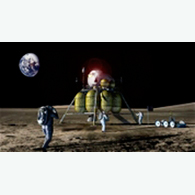(AP) - NASA may be going to the same old moon with a ship that looks a lot like a 1960s Apollo capsule, but the space agency said Monday that it's going to do something dramatically different this time: Stay there.
Unveiling the agency's bold plan for a return to the moon, NASA said it will establish an international base camp on one of the moon's poles, permanently staffing it by 2024, four years after astronauts land there, reports Trend.
It is a sweeping departure from the Apollo moon missions of the 1960s and represents a new phase of space exploration after space shuttles are retired in 2010.
NASA chose a "lunar outpost" over the short expeditions of the '60s. Apollo flights were all around the middle area of the moon, but NASA decided to go to the moon's poles because they are best for longer-term settlements. And this time NASA is welcoming other nations on its journey.
The more likely of the two lunar destinations is the moon's south pole because it's sunlit for three-quarters of the time. That offers a better locale for solar power, plus the site has possible resources to mine nearby, said associate deputy administrator Doug Cooke.
"This is not your father's Apollo," said John Logsdon, director of the Space Policy Institute at George Washington University. "I think it's the only way to sustain something like this over decades. This is not a flag-and-footprints. This is the idea of starting an outward movement that includes long stays on the moon."
To get to the moon, NASA will use two vehicles the Orion exploration vehicle and an attached all-purpose lunar lander that could touch down anywhere and be the beginnings a base camp, said exploration chief Scott Horowitz.
He likens the lander to a pickup truck.
"You can put whatever you want in the back. You can take it to wherever you want. So you can deliver cargo, crew, do it robotically, do it with humans on board. These are the types of things we're looking for in this system," Horowitz said at a news conference in Houston.
In 2004, the year after the shuttle Columbia accident that killed seven astronauts, President Bush announced a plan to return astronauts to the moon by 2020, and a later mission to Mars. The 16-year-long venture to the moon will take twice as long as NASA's first trip there took in planning.
Last year, NASA said it would cost $104 billion just to get back to the moon for its first trip, but on Monday NASA officials declined to estimate the larger costs of a permanent lunar program. They just said it would stay within NASA's budget.
The estimated time frame for NASA's lunar plans are:
2009 a first test of one of the lunar spaceships.
2014 the first manned test flight of the Orion crew exploration vehicle, but no moon landing.
2020 the first flight of the four-astronaut crew to the moon.
For four years, the lunar base won't be built up enough for long visits, so astronauts will only spend a week at a time. But after that, NASA envisions people living on the moon for six-month stints.
NASA also hopes that hydrogen, oxygen and other moon resources can be used as supplies for the lunar outpost. Eventually, getting oxygen there may be simple enough that it could be turned over to a commercial supplier, Horowitz said.
NASA's vision for the moon is more than just American astronauts it includes space travelers from other countries and even commercial interests, if possible.
Having other countries sign onto the project would save NASA money, although the United States will design the moon vehicles, NASA Deputy Administrator Shana Dale said. And while NASA welcomed its current partners on the international space station Russia, Europe and Japan the agency was cagey about its most enigmatic space rival, China, which has made noises about going to the moon.
NASA Administrator Michael Griffin was dispatched to China earlier this year, but so far discussions with China are only about earth science and space junk, Dale said. She said including China in lunar plans is "not one of our charges."
The key decision for NASA in its planning was whether to have a permanent settlement, and that drove other decisions, Dale said. Going with a permanent base was an outcome of NASA asking itself and more than 1,000 experts from 14 nations the questions: "Why are we returning to the moon and what we plan to do when we get there?"
Two key themes, according to NASA, were to prepare for future exploration, with Mars the next stop, and expansion of human civilization. Both NASA's science and engineering communities agreed on a permanent outpost, an agreement rare for two conflicting sides of the agency, Horowitz said.
The lunar plan calls for a commitment of money over the next three presidential terms, raising questions about future funding. But University of Texas aerospace engineering professor Hans Mark, a former NASA deputy administrator, gives the new plan an 80 percent chance of getting the money to put people on the moon by 2020.
While a more permanent base on the moon makes sense, American University public policy professor Howard McCurdy, who has written several books about NASA, fears the space program may stop there and not continue with President Bush's plans to continue to Mars.
His concern is based on cost and technology, McCurdy said. NASA doesn't plan to get additional money for its lunar program and will simply use money that had gone to the space shuttle program; much of the technology is based on expensive Apollo hardware, he said. So NASA has vowed to be creative with spending and technology, he said.
"The tooth fairy is not going to drop $500 to $800 billion on NASA," McCurdy said. "Being creative on the moon can sometimes get you confined to the moon."






